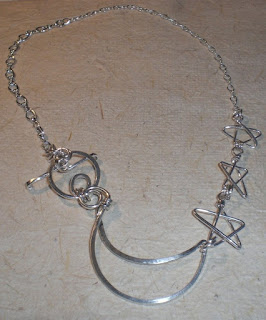
"My name is Daisy, and I'm a chainmaille addict." And this picture is the proof! (Mind you, there's one more doggie necklace that Mandy is already wearing, so I don't have a picture of that necklace in here...)
For the last 2 weeks, I've been reading and experimenting with more chainmaille patterns. There is an enormous amount of info on the web, from photos, tutorials, videos on YouTube, resources for materials, just incredible! One can get lost in all this (and I did.)
So far, I already ran thru my stash of 14 and 16 ga silver wires, and very little 12 left. Although 18 thru 22 are still in good supply, but I thought it'd be nice to add some colors. Unfortunately (and fortunately), my color craft wires are all 22 and thinner. To make up for the thickness, I twisted lots of them. A LOT! Any way, here's what I've made so far.

This is another Kingsmaille with 18 ga gold color wire and 3 colors of 22 ga blue and green twisted wires. Very oceany. AR is 9, kind of loopy; total length 17", sits just over collar bones. Originally, it's to be Tango's necklace. But when I tried it on him, his thick double coat just proved to be too much. Besides, it's probably not sturdy enough as a doggie necklace ... So I added a few more inches and decided to keep it for myself!!

OK, enough Kingsmaille for now. Off to learn some new pattern. These are Half Persians. Boy, talk about addicting! I made a small segment of HP 3-in-1, and I was so excited that I went on to try HP 4-in-1. Definitely takes more time than 3-in-1, but looks really cool! This ring is a small 4-in-1 with 18 ga silver and copper color craft wires.
More images
here.
So now I'm getting a feel for HP4-in-1, I thought this'll be a nice choice for a doggie necklace, it's rather sturdy even with just 18 ga. But by

now, I also ran out of 18 ga craft wire. A few poking arounds on the net gave me the idea of using aluminum wire. It's cheap, and I can probably find it at HomeDepot, saving me a trip to the beads store which has historically been expensive no matter how I cut it.
This is Tango's necklace, 16", 18 ga bright aluminum and twisted 26 ga Artistic Wires in shades of blue and green and some gold. All rings are about 5.5 AR. This is the first time I use aluminum wire; HomeDepot carries several gauges and tempers; I got the soft one, and it's real soft, almost no springback; cuts very easily (mars easily too). For small rings in HP 4-in-1, they'll do.

I was on a roll. Besides, I twisted and cut a whole bunch of color wires; a good exercise for my arms. Here's the necklace for Jimbo, 22.5"; wonder if this may be too long ... haven't tried either on them yet. Any how, I love these rainbow colors. So bright and cheery; sure would be nice to try the same again with silver and anodized niobium wires. Well, maybe after I get a new contract, but then I may not have as much time for my jewelry, humm ...
More image
here.

And lastly, but not least. My first try of the Stepping Stone pattern, and I REALLY like it! I first saw this in
CWJ 2009, then it led me to
this totally awesome site. Wow, just blown away! I knew about Japanese weave for a while, was never too interested to try; but this completely changed my mind. After days of googling, found more info on this pattern, here's my version of the bracelet. Made with 18 ga aluminum wire, 3 mm ID, 18 ga copper wire, 5 mm ID, and 16 ga brass wire, 8 mm ID. From start to end, took me 6+ hours, including some searching around the house for scrap brass wires (it's raining today, don't feel like

going to the stores ...) I improvised the toggle and the connectors for the toggle bar, which took me quite a while to fit just right. The goal is to make the toggle in a way that looks part of the bracelet, and don't look too out of place even if it ends up on top. I'm wearing this to sleep tonight:-)
More images
here.
 Jens Pind Linkage, or JPL for short.
Jens Pind Linkage, or JPL for short.



























